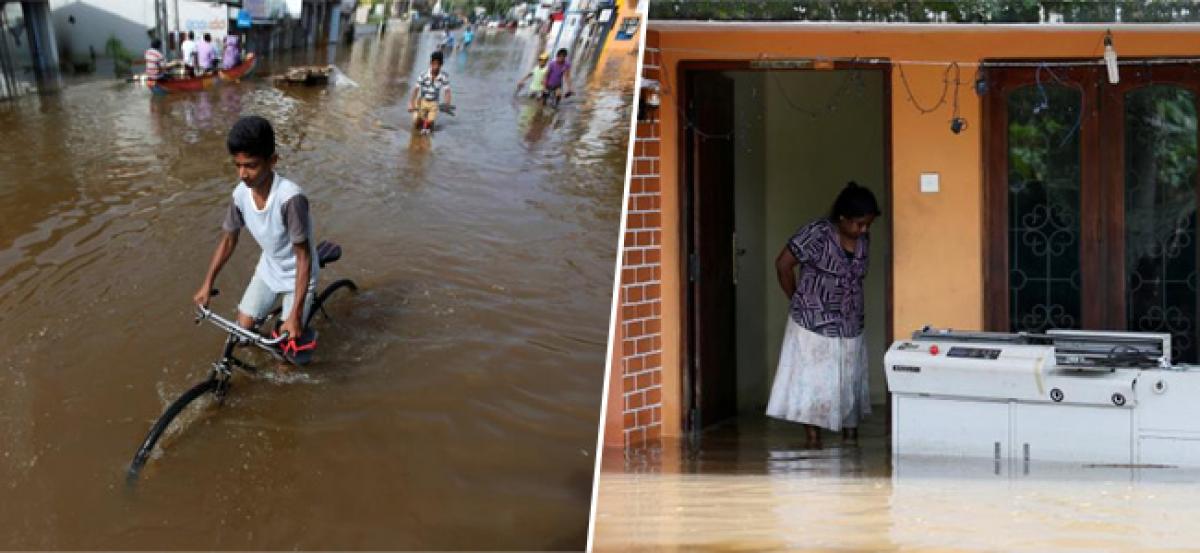Live
- Chanchalguda Jail Officials Say They Haven't Received Bail Papers Yet, Allu Arjun May Stay in Jail Tonight
- BJP leaders present evidence of illegal voters in Delhi, urge EC for swift action
- Exams will not be cancelled: BPSC chairman
- Nagesh Trophy: Karnataka, T.N win in Group A; Bihar, Rajasthan triumph in Group B
- YS Jagan condemns the arrest of Allu Arjun
- Economic and digital corridors to maritime connectivity, India and Italy building vision for future, says Italian Ambassador
- SMAT 2024: Patidar's heroics guide Madhya Pradesh to final after 13 years
- CCPA issues notices to 17 entities for violating direct selling rules
- Mamata expresses satisfaction over speedy conviction in minor girl rape-murder case
- Transparent Survey Process for Indiramma Housing Scheme Directed by District Collector
Just In

A cyclone grew in strength as it churned north towards Bangladesh on Monday after heavy rain in rural Sri Lanka and thunderstorms in eastern India killed almost 200 people, with more torrential downpours forecast.
AGALAWATTE, SRI LANKA: A cyclone grew in strength as it churned north towards Bangladesh on Monday after heavy rain in rural Sri Lanka and thunderstorms in eastern India killed almost 200 people, with more torrential downpours forecast.
Floods and landslides in tropical Sri Lanka, off India's southern tip, have killed at least 169 people in recent days, authorities said, with 24 killed in storms in the eastern Indian state of Bihar, either by lightning strikes or under collapsed village huts.
India warned of heavy rains in the northeastern states of Tripura, Mizoram, Manipur, Nagaland and Arunachal Pradesh as Cyclone Mora moved further up the Bay of Bengal.
Floods reached roof level and cut off access to many rural Sri Lankan villages, disrupting life for half a million people, many of them workers on rubber plantations, officials said.
Villagers in Agalawatte, in a key rubber-growing area 74 km (46 miles) southeast of the capital, Colombo, said they were losing hope of water levels falling soon after the heaviest rain since 2003. Fifty-three villagers died and 58 were missing.
"All access to our village is cut off. A landslide took place inside the village and several houses are buried," Mohomed Abdulla, 46, told Reuters.
Some areas in the southern coastal district of Galle, popular with foreign tourists, have not received relief due to lack of access.
"My entire village is cut off and nobody can come to this village," C.M. Chandrapla, 54, told Reuters by phone from the tourist village of Neluwa.
"There have been no supplies for the past two days. Water has gone above three-storey buildings and people survive by running to higher ground."
Bangladesh is hit by cyclones, many of them devastating, every year. Half a million people had their lives disrupted in low-lying coastal areas such as Barisal and Chittagong in May last year.
Authorities will relocate thousands from coastal areas before Mora hits, government officials said. About 10 million of Bangladesh's population of 160 million live in low-lying coastal areas.
"We have taken all sorts of steps to minimize any losses, including moving people away from the most vulnerable areas," Kazi Adbur Rahman, a senior government official in Cox's Bazaar, told Reuters by telephone.
The Sri Lankan military has sent in helicopters and boats in rescue efforts in the most widespread disaster since the 2004 Boxing Day tsunami. About 100 people were missing in total.
The meteorology department forecast torrential rains over the next 36 hours.
Residents in seven densely populated districts in the south and center of Sri Lanka were asked to move away from unstable slopes in case of further landslides.
The wettest time of the year in Sri Lanka's south is usually during the southern monsoon, from May to September. The island also receives heavy rains in the North West monsoonal season from November to February.
Reuters witnessed some people stranded on the upper floors of their homes. Civilians and relief officials in boats distributed food, water and other relief items.
One of the worst-hit areas was the southern coastal district of Matara which is home to black tea plantations. Rohan Pethiyagod, head of the Tea Board in the world's largest exporter of top quality teas, said supplies would be disrupted for the next auction due to a lack of transportation.
Sri Lanka has already appealed for international assistance from the United Nations and neighboring countries.

© 2024 Hyderabad Media House Limited/The Hans India. All rights reserved. Powered by hocalwire.com







